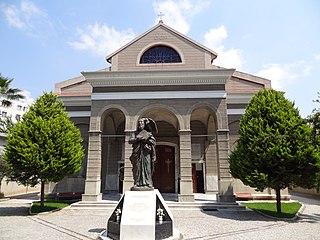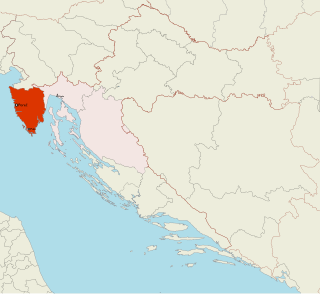
The Latin Patriarchate of Constantinople was an office established as a result of the Fourth Crusade and its conquest of Constantinople in 1204. It was a Roman Catholic replacement for the Eastern Orthodox Ecumenical Patriarchate of Constantinople and remained in the city until the reconquest of Constantinople by the Byzantines in 1261, whereupon it became a titular see. The office was abolished in 1964.

The Patriarch of Venice is the ordinary bishop of the Archdiocese of Venice. The bishop is one of only four patriarchs in the Latin Church of the Catholic Church. The other three are the Patriarch of Lisbon, the Patriarch of the East Indies and the Latin Patriarch of Jerusalem. Presently, the only advantage of this purely formal title is the bishop's place of honor in papal processions. In the case of Venice, an additional privilege allows the patriarch, even if he is not a cardinal, the use of the colour red in non-liturgical vestments. In that case, the red biretta is topped by a tuft, as is the custom with other bishops who are not cardinals.

The Contarini is one of the founding families of Venice and one of the oldest families of the Italian Nobility. In total eight Doges to the Republic of Venice emerged from this family, as well as 44 Procurators of San Marco, numerous ambassadors, diplomats and other notables. Among the ruling families of the republic, they held the most seats in the Great Council of Venice from the period before the Serrata del Maggior Consiglio when Councillors were elected annually to the end of the republic in 1797. The Contarini claimed to be of Roman origin through their patrilineal descendance of the Aurelii Cottae, a branch of the Roman family Aurelia, and traditionally trace their lineage back to Gaius Aurelius Cotta, consul of the Roman Republic in 252 BC and 248 BC.
The Latin Patriarchate of Alexandria was a nominal patriarchate of the Latin church on the see of Alexandria in Egypt.

This is a list of the Patriarchs of Grado.

The Patriarchate of Aquileia was an episcopal see and ecclesiastical province in northeastern Italy, originally centered in the ancient city of Aquileia, situated near the northern coast of the Adriatic Sea. It emerged in the 4th century as a metropolitan province, with jurisdiction over the Italian region of Venetia et Histria. In the second half of the 6th century, metropolitan bishops of Aquileia started to use the patriarchal title. Their residence was moved to Grado in 568, after the Lombard conquest of Aquileia. In 606, an internal schism occurred, and since that time there were two rival lines of Aquileian patriarchs: one in New Aquileia (Grado) with jurisdiction over the Byzantine-controlled coastal regions, and the other in Old Aquileia. The first line (Grado) continued until 1451, while the second line continued until 1751. Patriarchs of the second line were also feudal lords of the Patriarchal State of Aquileia. A number of Aquileian church councils were held during the late antiquity and throughout the middle ages. Today, it is a titular archiepiscopal see.

The Roman Catholic Metropolitan Archdiocese of İzmir is a Latin archdiocese of the Roman Catholic Church in Asian Turkey (Anatolia).

The Roman Catholic Diocese of Poreč and Pula is a suffragan Latin diocese in the ecclesiastical province of the Metropolitan Archdiocese of Rijeka on Istria peninsula, in Croatia.
The Diocese of Chios is a Latin Church diocese of the Catholic Church located on the island of Chios in the ecclesiastical province of Naxos, Andros, Tinos and Mykonos in Greece.

The Archdiocese of Corfu, Zakynthos, and Cefalonia is a Latin Church ecclesiastical territory or archdiocese of the Catholic Church comprising the Ionian islands of Corfu, Zakynthos and Cephalonia in western Greece.
Pseudocardinals, quasi-cardinals or anticardinals were the uncanonical Cardinals created by six of the Antipopes, in or rival to Rome, including two of Avignon Papacy and one of Pisa, as princes of their schismatic government of the Catholic Church.
This article presents a detailed timeline of the history of the Republic of Venice from its legendary foundation to its collapse under the efforts of Napoleon.

The Diocese of Castello, originally the Diocese of Olivolo, is a former Roman Catholic diocese that was based on the city of Venice in Italy. It was established in 774, covering the islands that are now occupied by Venice. Throughout its existence there was tension between the diocese, the Patriarchate of Grado to which it was nominally subordinate, and the Doge of Venice. Eventually in 1451 the diocese and the patriarchate were merged to form the Archdiocese of Venice.
The Roman Catholic Diocese of La Canea or Cidonia was a bishopric on Crete, with see at present Chania, and afterward was twice a Latin titular see.
The bailo and captain of Negroponte was the representative of the Republic of Venice stationed at Chalcis (Negroponte) on the island of Euboea. The bailo played an important role as the mediator between, and de facto overlord of, the triarchs of Euboea, who had their common residence in Negroponte. The triarchies were created by the division of the island between three rulers (triarchs) after its conquest following the Fourth Crusade (1204).
The Eparchy of Latakia or Latakia of the Maronites is a Maronite Church ecclesiastical territory or eparchy of the Catholic Church in Syria. As of 2011, there were 35,000 members. The current eparch is Antoine Chbeir.
The Diocese of Novigrad was a Latin Church ecclesiastical jurisdiction or diocese of the Catholic Church located in the city of Novigrad, Istria, Croatia until it was suppressed to the Diocese of Trieste in 1831.
This is an alphabetical index of people, places, things, and concepts related to or originating from the Republic of Venice. Feel free to add more, and create missing pages.

The Querini family or Quirini was an old Venetian patrician family. They claimed an ancient Roman heritage, but their traceable history goes back to the 11th century. The family divided into many branches.

Maffeo Vallaresso or Valaresso (1415–1494) was a Venetian patrician, Renaissance humanist and prelate who served as the archbishop of Zadar (Zara) from 1450 until his death. A doctor in canon law and a collector of Greek and Latin manuscripts, he tried unsuccessfully on at least four occasions to be transferred to a more prestigious see.











